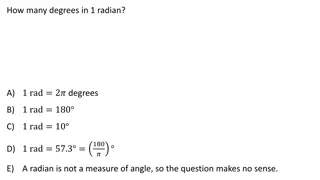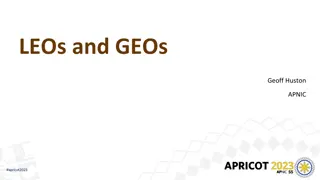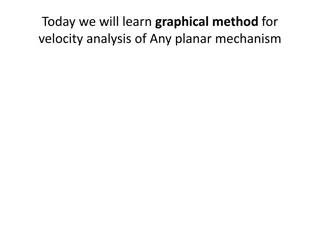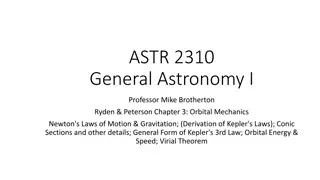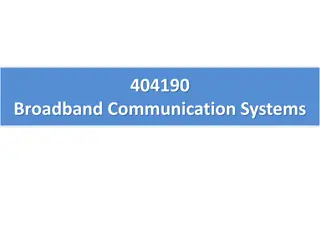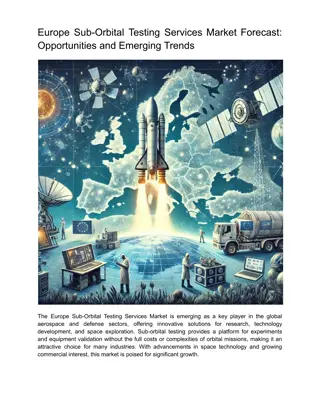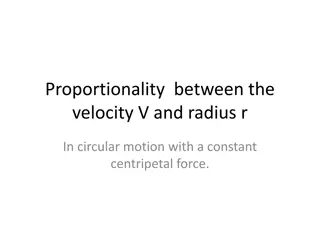Impacts of Thermosphere Contraction on Debris Accumulation and Orbital Capacity
Explore the effects of thermosphere contraction on debris accumulation and orbital capacity, as discussed in a workshop at Politecnico di Milano. Satellite observations reveal increasing COx levels, impacting the upper atmosphere's chemistry. The concern for space debris management is highlighted, e
1 views • 29 slides
Influence of Solar Activity and Orbital Motion on Terrestrial Atmosphere
Solar magnetic field reversal, wavelet spectral analysis, and proxies for solar activity index are discussed in relation to the joint effects of solar activity and solar orbital motion on the Earth's atmosphere. The study highlights the impact of solar cycles on terrestrial climate dynamics and temp
7 views • 16 slides
Orbits and Motion in Astrophysics
Explore the concept of orbits and motion in astrophysics, covering gravitational forces, planetary orbits, orbital speeds, and celestial phenomena like lunar eclipses. Delve into how objects move in space, the relationships between orbital speed, radius, and time period, and the dynamics of celestia
1 views • 14 slides
Chemistry Regents August 2022: Questions and Answers
Explore the answers to questions from the August 2022 Chemistry Regents exam, covering topics like electron configuration, orbital definition in the wave-mechanical model, and electron energy shells in atoms. Understand concepts such as the number of protons in an atom, orbital definitions, and elec
0 views • 167 slides
Velocity vs. Speed in Physics
Velocity and speed are fundamental concepts in physics that describe how fast an object is moving and in what direction. While speed is a scalar quantity representing the rate of motion, velocity is a vector quantity that includes both speed and direction. Constant velocity implies steady speed and
1 views • 8 slides
Flow Measurement Using V-Notch and Weirs in Engineering
Flow measurement in engineering involves the use of V-notch and weirs, such as rectangular weirs and triangular weirs, to calculate discharge rates and velocity of liquids. A V-notch is a triangular obstruction used for flow measurement, while weirs are larger scale structures for measuring river or
1 views • 7 slides
Crystal Field Theory in Chemistry
Crystal Field Theory (CFT) explains how electron orbital degeneracies, particularly d or f orbitals, are affected by a static electric field generated by neighboring anions. In CFT, the metal ion is considered positive while ligands are negative charges, leading to attractive and repulsive forces af
0 views • 13 slides
Determining Ultrasonic Wave Velocity in Liquid Using Interferometer
An ultrasonic interferometer apparatus is used to determine the velocity of ultrasonic waves in a liquid medium by creating longitudinal stationary waves and utilizing the principles of diffraction. The experiment involves passing monochromatic light through the liquid, creating an acoustic grating,
1 views • 16 slides
Velocity: The Key to Motion
Velocity is the speed and direction at which an object moves, indicating both its position and rapidity. It is crucial for measuring the rate of change of an object's position over time and differentiates from speed as a vector quantity. This comprehensive guide delves into the concepts of velocity,
3 views • 33 slides
Relative Velocity and Acceleration in Physics
Relative velocity is defined as the velocity of an object in the rest frame of another object, and it can be negative depending on the difference in velocities. The need for using relative velocity lies in determining if an object is at rest or moving. The formula for relative velocity involves the
1 views • 25 slides
Orbital Mechanics: Kepler's Laws, Center of Mass, and Equation of Motion
Exploring the fundamental concepts in orbital mechanics including Kepler's Laws, center of mass calculations, and equations of motion for celestial bodies. Topics covered include the laws of planetary motion, center of mass reference frame, and the concept of reduced mass in celestial mechanics.
1 views • 15 slides
Physics Concepts: Angular Velocity, Radians, and Acceleration Explained
Understand essential physics concepts such as angular velocity in radians, comparison of angular velocities, tangential velocity, magnitudes of velocities, and angular acceleration as applied to various scenarios like rotating wheels, clock hands, and spinning objects. Dive into the relationships be
1 views • 31 slides
Orbital Dynamics: Kepler's Laws and Newtonian Gravity
Delve into the fascinating world of orbital dynamics as we explore Kepler's Laws and Newtonian Gravity. From understanding the elliptical orbits of planets around the Sun to uncovering the role of gravity in shaping celestial motion, this journey will illuminate the fundamental principles governing
0 views • 18 slides
Orbital Altitudes and Satellite Services
Explore the fascinating realm of orbital altitudes and satellite services, including the differences between Low Earth Orbit (LEO) and Geostationary Earth Orbit (GEO). Learn about the physics behind satellite trajectories and how services like Starlink and Skymuster provide unique communication solu
1 views • 35 slides
Electron Configuration and Quantum Numbers in Chemistry
Explore the concept of electron configurations, quantum numbers, and orbital filling rules in chemistry. Discover the principles governing the arrangement of electrons in atoms, including the Aufbau Principle, Pauli Exclusion Principle, and Hund's Rule. Gain insight into orbital energy levels and th
1 views • 18 slides
Quantum Mechanics in Chemistry Lecture 1 Overview
Explore the fundamentals of quantum mechanics in chemistry, focusing on electron behavior, orbital solutions, bonding, and interactions. Learn about the role of different orbitals, resonance, and orbital mixing in the Schrödinger equation to understand molecular structure and behavior.
0 views • 24 slides
Relative Velocity of Bodies in Motion
The content explains concepts related to relative velocity of moving bodies, including diagrams illustrating velocity relationships, application of laws of parallelogram and triangle, analysis of motion in rigid links, and calculation of rubbing velocity at pin joints in mechanisms. It covers scenar
0 views • 23 slides
Graphical Method for Velocity Analysis of Planar Mechanisms
Learn about the graphical method for velocity analysis of planar mechanisms through practice problems involving slider-crank mechanisms and link velocities. Understand how to calculate slider velocity, point velocity, and angular velocities using the given dimensions and rotational speeds. Visualize
0 views • 6 slides
Measurement of Flow Velocity on Frozen and Non-Frozen Slopes of Black Soil Using Leading Edge Method
This study presented a detailed methodology for measuring flow velocity on frozen and non-frozen slopes of black soil, focusing on the Leading Edge method. The significance of shallow water flow velocity in soil erosion processes was emphasized. Various methods for measuring flow velocity were compa
0 views • 23 slides
Strategies for Generating Velocity Solutions with GLOBK
Basics of velocity solutions, setup strategies, and data cleaning methods for optimizing GLOBK solutions to generate position, velocity, offset, and postseismic parameter estimates. The aim is to combine years of data, make critical decisions on data treatment, and ensure accuracy in the process noi
1 views • 22 slides
Molecular Orbital Diagrams for Diatomic Molecules
Explore the intricacies of MO diagrams for diatomic molecules like O2, delving into electron configurations, bond orders, and orbital mixing effects. Discover how MO theory offers a more accurate depiction of molecular structures compared to traditional Lewis dot structures.
0 views • 12 slides
Link Budget Analysis for Cubesat Earth Observation Mission
This research paper discusses the link budget analysis for a proposed Cubesat Earth observation mission, covering aspects such as Cubesat dimensions, mission objectives, communication parameters, orbital mechanics, and current missions in various frequency bands. Key topics include mapping light pol
0 views • 24 slides
Orbital Dynamics: From Newton's Laws to Kepler's Laws
Exploring the fascinating realm of orbital dynamics, this content delves into the application of Newton's laws to explain Kepler's laws and the intricacies of orbital mechanics. Deriving Kepler's laws from Newton's law of gravitation involves advanced mathematics, while also emphasizing the signific
0 views • 25 slides
Exploration of Double Degenerates in White Dwarf Binaries
The search for double degenerates in white dwarf binaries involves techniques like eclipses, ellipsoidal modulation, and irradiation of companions. Discoveries such as an orbital period of 20 minutes, orbital decay measurements, and technical challenges in data processing using GPUs are highlighted.
1 views • 14 slides
Motion: Speed, Velocity, and Acceleration
Motion is the change in position of an object relative to a reference point. Speed is the distance traveled divided by the time interval, while velocity includes direction. Acceleration refers to the rate of change of velocity. Different concepts and scenarios related to motion, speed, velocity, and
1 views • 16 slides
Broadband Communication Systems and Satellite Communications
Broadband communication systems involve the use of satellites for various applications such as TV services, data services, and communication with ships and aircraft. This content delves into orbital mechanics, the gravitational forces in satellite orbits, as well as the orbital heights and velocitie
0 views • 57 slides
Orbital Mechanics and Satellites Overview
This content provides calculations for the orbital speed and period of the International Space Station, as well as the orbital radius of an Earth satellite with a 24-hour period. It explains the concept of artificial satellites, different types of orbits such as Low Earth Orbit (LEO), Medium Earth O
0 views • 17 slides
The Orbital Region: An Overview
The orbital region encompasses the orbits, eyelids, ciliary and tarsal glands, and anatomical borders. It consists of bony cavities protecting the eyeballs, eyelids that shield the eyes, and intricate structures like the lacrimal apparatus and muscles. Understanding the components and anatomical rel
0 views • 15 slides
Speed and Velocity in Physics
Speed and velocity are fundamental concepts in physics. Speed is a scalar quantity that can be average or instantaneous, while velocity is a vector quantity that includes direction. Equations such as v=d/t help calculate these values. Average speed and average velocity are important in determining t
1 views • 10 slides
Analyzing Firing Velocity of N-Strike Elite Nerf Gun by Haley Vermette
Haley Vermette conducted a project to test the claim made by Hasbro about the N-Strike Elite Nerf Gun's shooting range. Through critical thinking, problem-solving, and testing, various variables like time, distance, muzzle height, and firing velocity were analyzed to support or disprove the claim on
1 views • 15 slides
Europe Sub-Orbital Testing Services Market Forecast & Opportunities
The Europe sub-orbital testing services market is estimated to reach $30.7 million by 2032 from $16.4 million in 2022, at a CAGR of 6.48% during the forecast period 2022-2032.\n\nRead Report Overview: \/\/bisresearch.com\/industry-report\/europe-sub-
1 views • 3 slides
Impact of Velocity Field Variations on Pulsar Magnetic Fields
The study explores how variations in velocity fields affect pulsar magnetic fields, highlighting the conversion of kinetic energy to magnetic energy in pulsars. Glitches in these systems can lead to changes in magnetic fields, influencing pulsar emissions. The maintenance of stable magnetic fields a
0 views • 14 slides
Motion and Velocity Concepts Illustrated Quiz Review
Explore concepts of distance, speed, displacement, and velocity through examples of a moving truck's position, Julie's journey to meet her friends, and calculations of velocity for trips from Pittsburgh to Philadelphia and Hong Kong to Los Angeles. Understand the differences between speed and veloci
0 views • 8 slides
Sub-Orbital Testing Services Market
The global sub-orbital testing services market is estimated to reach $178.1 million in 2032 from $122.4 million in 2022, at a CAGR of 3.82% during the forecast period 2022-2032.\n\nRead Report Overview: \/\/bisresearch.com\/industry-report\/sub-orbit
1 views • 3 slides
One-Dimensional Motion and Velocity Measurements
Exploring the concept of velocity measurement in one-dimensional motion, this content delves into the sampling rate, coordinate systems, and the relationship between position and time. It discusses average velocity, instantaneous velocity, and the significance of slope on graphs representing motion.
0 views • 22 slides
Orbital Motion and Circular Velocity in Physics
Explore the concept of orbital motion and circular velocity in physics, where we delve into the relationship between velocity and radius in circular motion with a constant centripetal force. Through Newton's 2nd Law and gravitational forces, we uncover the dependence of satellite speed on the radius
0 views • 13 slides
Curvilinear Motion in 3D Space
curvilinear motion in 3D space involves describing particle position using a position vector, exploring relationships between position, velocity, and acceleration, and visualizing motion through coordinate systems. This concept delves into position vectors, displacement, velocity - both average and
0 views • 16 slides
Vectors and Velocity
Vectors in space specified by three numbers, position vectors, adding vectors algebraically, notation, velocity concepts, 2-D coordinates, 1D velocity, graphing velocity, position to velocity ratio. Explore how direction and displacement relate to velocity over time.
0 views • 12 slides
Ultra-HD 4K Camera Drone with Remote Control and Orbital Flight Mode
Capture stunning Ultra-HD 4K videos with this new arrival drone featuring a 4K FVP camera, GPS, WiFi, and Fold & Stow design for portability. Enjoy 22 minutes of flying time, remote-controlled precision, and creative functions like Orbital Flight Mode for dynamic aerial shots. Explore Track & Follow
0 views • 12 slides
Explore Atomic Structure and Quantum Mechanics in Chemistry Activities
Dive into the world of atomic structure and quantum mechanics through interactive activities, including determining proton, neutron, and electron counts in Copper-65, understanding valence and core electrons, reviewing atomic models, and exploring orbital shapes. Get hands-on with the Bohr model, Qu
0 views • 11 slides











